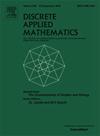二方图和完美图中预算最大权重独立集的严格界限
IF 1
3区 数学
Q3 MATHEMATICS, APPLIED
引用次数: 0
摘要
我们考虑的是经典的预算最大权重独立集(BMWIS)问题。输入是一个图 G=(V,E),其中每个顶点 v∈V 都有权重 w(v)、成本 c(v)和预算 B。目标是在 G 中找到一个独立集 S⊆V,使得∑v∈Sc(v)≤B,从而最大化总权重∑v∈Sw(v)。由于对于任意ɛ>0,一般图上的问题无法在比率 |V|1-ɛ 内近似解决,因此 BMWIS 在可以在多项式时间内计算最大权重独立集的图族中引起了极大关注。其中两个著名的图族是二方图和完美图。众所周知,BMWIS 在这两个图族上都是 NP-hard;然而,在这项工作之前,这些图的最佳近似保证还没有定论。特别是,我们根据小集扩展假说 (SSEH),给出了双方形图上 BMWIS 的 (2-ɛ) 下限,这已经适用于预算被万有引力约束取代的特殊情况。对于上界,我们使用基于拉格朗日松弛的技术,为完美图上的 BMWIS 设计了一个 2 近似值。最后,我们得到了有容最大权重独立集(CMWIS)问题的紧密下界,该问题是 BMWIS 的特例,其中 w(v)=c(v)∀v∈V 。我们的研究表明,双方图和完美图上的 CMWIS 不可能有高效的多项式时间逼近方案(EPTAS)。因此,针对 CMWIS 的现有 PTAS 基本上是我们所能期待的最佳方案。本文章由计算机程序翻译,如有差异,请以英文原文为准。
Tight bounds for budgeted maximum weight independent set in bipartite and perfect graphs
We consider the classic budgeted maximum weight independent set (BMWIS) problem. The input is a graph , where each vertex has a weight and a cost , and a budget . The goal is to find an independent set in such that , which maximizes the total weight . Since the problem on general graphs cannot be approximated within ratio for any , BMWIS has attracted significant attention on graph families for which a maximum weight independent set can be computed in polynomial time. Two notable such graph families are bipartite and perfect graphs. BMWIS is known to be NP-hard on both of these graph families; however, prior to this work, the best possible approximation guarantees for these graphs were wide open.
In this paper, we give a tight 2-approximation for BMWIS on perfect graphs and bipartite graphs. In particular, we give a lower bound for BMWIS on bipartite graphs, already for the special case where the budget is replaced by a cardinality constraint, based on the Small Set Expansion Hypothesis (SSEH). For the upper bound, we design a 2-approximation for BMWIS on perfect graphs using a Lagrangian relaxation based technique. Finally, we obtain a tight lower bound for the capacitated maximum weight independent set (CMWIS) problem, the special case of BMWIS where . We show that CMWIS on bipartite and perfect graphs is unlikely to admit an efficient polynomial-time approximation scheme (EPTAS). Thus, the existing PTAS for CMWIS is essentially the best we can expect.
求助全文
通过发布文献求助,成功后即可免费获取论文全文。
去求助
来源期刊

Discrete Applied Mathematics
数学-应用数学
CiteScore
2.30
自引率
9.10%
发文量
422
审稿时长
4.5 months
期刊介绍:
The aim of Discrete Applied Mathematics is to bring together research papers in different areas of algorithmic and applicable discrete mathematics as well as applications of combinatorial mathematics to informatics and various areas of science and technology. Contributions presented to the journal can be research papers, short notes, surveys, and possibly research problems. The "Communications" section will be devoted to the fastest possible publication of recent research results that are checked and recommended for publication by a member of the Editorial Board. The journal will also publish a limited number of book announcements as well as proceedings of conferences. These proceedings will be fully refereed and adhere to the normal standards of the journal.
Potential authors are advised to view the journal and the open calls-for-papers of special issues before submitting their manuscripts. Only high-quality, original work that is within the scope of the journal or the targeted special issue will be considered.
 求助内容:
求助内容: 应助结果提醒方式:
应助结果提醒方式:


